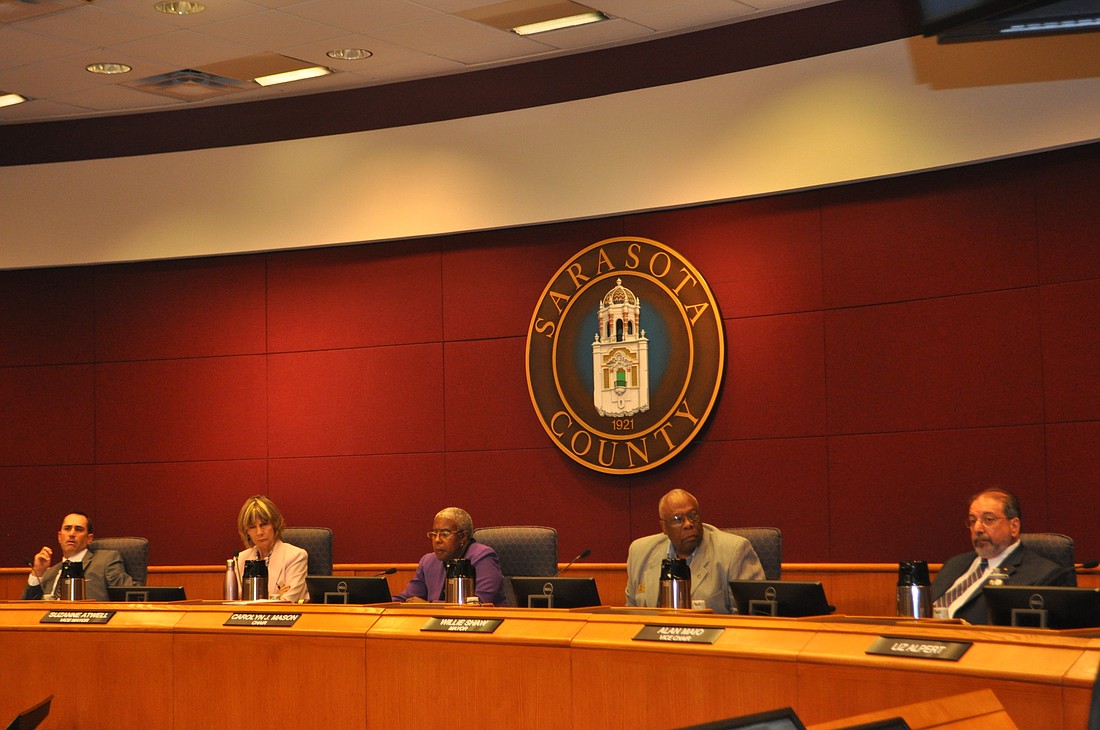- April 19, 2024
-
-
Loading

Loading

Today, both city and county commissioners said they believed the two governments were moving closer to a mutually acceptable solution for addressing homelessness issues in Sarasota.
Both boards directed their respective staffs to continue working with one another — and with independent community organizations involved with homelessness issues. Within the next 30 to 45 days, the commissions expect a report with a series of joint recommendations and additional data supporting any conclusions.
Members of both boards agreed that the two sides shared more common ground than their last joint meeting in June 2014, a sign of progress between two commissions often characterized as deeply divided.
“I see the light at the end of the tunnel, and I'm about 95% sure it's not a train,” County Commissioner Carolyn Mason said.
Still, philosophical differences between the two sides still exist. Members of both boards agreed that a shelter and housing were important components of a strategy to combat homelessness. Questions remain unanswered about funding, timing, scope and location for both of those components.
"I see the light at the end of the tunnel, and I'm about 95% sure it's not a train." — Carolyn Mason
Doug Logan, the city’s director of special initiatives on chronic homeless, presented the city’s “housing first” philosophy to both boards. That approach prioritizes placing individuals into homes as soon as possible, including some permanent supportive housing. Logan suggested a triage shelter in a Sarasota housing-first program — a briefer stopping point before individuals can be housed — would need 30 to 50 beds.
This contrasts with the county’s philosophy, which follows the recommendations of consultant Robert Marbut. County Homeless Coordinator Wayne Applebee explained the county’s desire for a come-as-you-are shelter that serves as a jail diversion program in addition to a homeless service center. Based on that approach, county staff was interested in a shelter with approximately 225 beds.
Logan believes officials should address the specific needs of homeless individuals in a separate facility from those cited for a specific offense.
“Unfortunately, the way I see it, the conversation has become overly complicated by putting two things in one place,” Logan said.
County commissioners signaled their willingness to compromise on the exact size of a shelter. However, several also expressed a concern that a smaller shelter lacking a jail diversion program would not be adequate for swiftly addressing problems associated with the presence of homeless individuals.
“The best thing that we can do for business in downtown Sarasota is address this homelessness problem,” County Commissioner Charles Hines said.
Likewise, city commissioners feared the impact of a larger come-as-you-are shelter on its surroundings, particularly if placed in north Sarasota. The county is in the process of exploring potential shelter sites outside of the city limits — including one directly across from the city border near U.S. 301 and Myrtle Street.
"I’d love to say we’ve come very far — we haven’t come very far." — Paul Caragiulo
Beyond the shelter discussion, the two boards also talked about other facets of a comprehensive homelessness strategy. Addressing housing and mental health issues — and exploring the creation of new revenue streams, such as a voter-approved taxing district — drew interest from both sides.
The commissions both voted unanimously to give city and county staff another 30 to 45 days to produce a series of recommendations for how to proceed. Despite the consensus, members of both boards expressed some skepticism about the approach. County Commissioners Al Maio and Charles Hines initially spoke in opposition to the extended study period, with Hines seeking a more solid commitment to constructing a shelter.
“It’s time to fish or cut bait,” Hines said.
City Commissioner Susan Chapman also continued her criticism of the Marbut-endorsed strategy, echoing Logan’s comments regarding the jail diversion approach.
“Homelessness is not a crime,” Chapman said. “Mental illness is not a crime. To think it’s a law enforcement issue is a mistake. We need to be thinking about it more as a social services issue.”
"Homelessness is not a crime. Mental illness is not a crime. To think it’s a law enforcement issue is a mistake." — Susan Chapman
Chapman called the come-as-you-are shelter a temporary solution, citing studies that supported the long-term effectiveness and financial efficiency of housing first.
“If we want to spend all our money on a transitional system rather than a permanent system, we may be spending money needlessly,” she said.
County Commissioner Paul Caragiulo said he was willing to work with the city to address many of its concerns regarding a shelter, but called on the city to be equally flexible when it came to compromising. Contrary to many of his colleagues, he expressed a skepticism regarding the amount of real progress the two sides had made.
“This issue has been exhausting,” Caragiulo said. “I’d love to say we’ve come very far. We haven’t come very far — we’re still trying to figure out what the words mean. We’re trying to figure out if the numbers are right.”
Still, members of both boards felt today’s meeting was a step in the right direction, and held out hope the dialog would help produce productive results in the future.
“I think it sounds like we’re really not far apart here in terms of what we would all like to see happen and what we would like to see done,” Alpert said. “We agree — yes, we need a shelter. But what size should it be, and what kind of a facility should it be?”